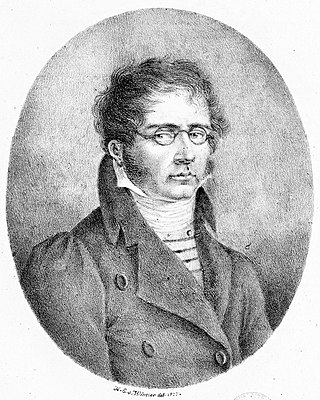
Franz Ignaz Danzi was a German cellist, composer and conductor, the son of the Italian cellist Innocenz Danzi (1730–1798) and brother of the noted singer Franzeska Danzi. Danzi lived at a significant time in the history of European music. His career, spanning the transition from the late Classical to the early Romantic styles, coincided with the origin of much of the music that lives in our concert halls and is familiar to contemporary classical-music audiences. In his youth he knew Wolfgang Amadeus Mozart, whom he revered; he was a contemporary of Ludwig van Beethoven, about whom he — like many of his generation — had strong but mixed feelings and he was a mentor for the young Carl Maria von Weber, whose music he respected and promoted.
A piano trio is a group of piano and two other instruments, usually a violin and a cello, or a piece of music written for such a group. It is one of the most common forms found in classical chamber music. The term can also refer to a group of musicians who regularly play this repertoire together; for a number of well-known piano trios, see below.
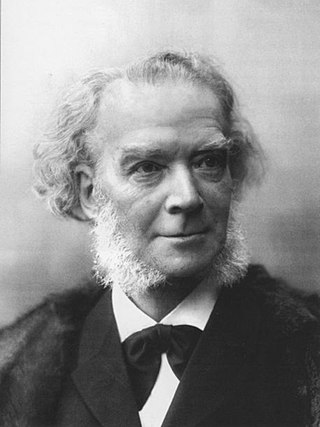
Carl Heinrich Carsten Reinecke was a German composer, conductor, and pianist in the mid-Romantic era.
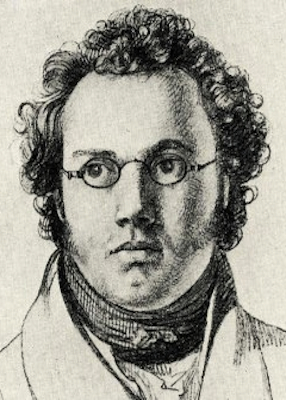
Franz Schubert's Symphony No. 5 in B♭ major, D. 485, was written mainly in September 1816 and completed on 3 October 1816. It was finished six months after the completion of his previous symphony.

Robert David Levin is an American classical pianist, musicologist, and composer. He was a professor of music at Harvard University from 1994 to 2014 and the artistic director of the Sarasota Music Festival from 2007 to 2017.
E-flat major is a major scale based on E♭, consisting of the pitches E♭, F, G, A♭, B♭, C, and D. Its key signature has three flats. Its relative minor is C minor, and its parallel minor is E♭ minor,.
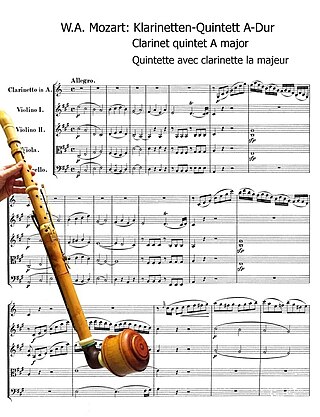
Wolfgang Amadeus Mozart's Clarinet Quintet, K. 581, was written in 1789 for the clarinetist Anton Stadler. A clarinet quintet is a work for one clarinet and a string quartet. Although originally written for basset clarinet, in contemporary performances it usually is played on a clarinet in A. It is Mozart's only completed clarinet quintet and is one of the earliest and best-known works, written especially for the instrument. It remains to this day one of the most admired of the composer's works. Sometimes the quintet is referred to as the Stadler Quintet; Mozart so described it in a letter of April 1790. Mozart also wrote a trio for clarinet, viola, and piano for Stadler, the so-called Kegelstatt Trio, in 1786. Stadler was a friend to Mozart who was very talented in the instrument.

Bernhard Heinrich Romberg was a German cellist and composer.

Anton Franz Josef Eberl was an Austrian composer, teacher and pianist of the Classical period. He was a student of Salieri and Mozart. He was also seen as an early friend and rival of Beethoven.
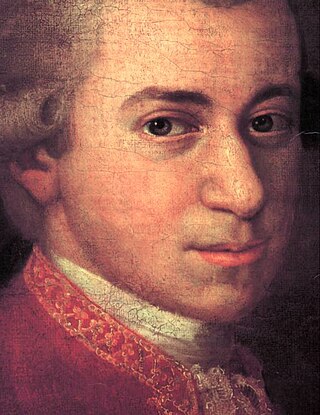
The Serenade No. 10 for winds in B-flat major, K. 361/370a, is a serenade by Wolfgang Amadeus Mozart scored for thirteen instruments: twelve winds and string bass. The piece was probably composed in 1781 or 1782 and is often known by the subtitle Gran Partita, though the title is a misspelling and not in Mozart's hand. It consists of seven movements.

Quintet in E-flat for Piano and Winds, Op. 16, was written by Ludwig van Beethoven in 1796.

Jaroslav Řídký was a Czech composer, conductor, harpist, and music teacher.
Harmonie is a German word that, in the context of the history of music, designates an ensemble of wind instruments employed by an aristocratic patron, particularly during the Classical era of the 18th century. The Harmonie would be employed for outdoor or recreational music, or as a wind section of an orchestra. Music composed for Harmonie is often called Harmoniemusik.
The String Quintet No. 2 in C minor, K. 406/516b, was written by Wolfgang Amadeus Mozart in 1787. Like all of Mozart's string quintets, it is a "viola quintet" in that it is scored for string quartet and an extra viola. Unlike his other string quintets, however, the work was not originally written for strings. Having completed the two string quintets K. 515 and K. 516, Mozart created a third by arranging his Serenade No. 12 for Winds in C minor K. 388/384a, written in 1782 or 1783 as a string quintet. Although by then Mozart was entering each new work into his catalogue of compositions, he did not enter this quintet, perhaps because it was an arrangement rather than a new work.
The Melos Ensemble is a group of musicians who started in 1950 in London to play chamber music in mixed instrumentation of string instruments, wind instruments and others. Benjamin Britten composed the chamber music for his War Requiem for the Melos Ensemble and conducted the group in the first performance in Coventry.
The divertimenti in F major, B-flat major, E-flat major, F major, and B-flat major are five companion compositions for pairs of oboes, horns and bassoons by Wolfgang Amadeus Mozart.
The bassoon repertoire consists of pieces of music composed for bassoon as a principal instrument that may be performed with or without other instruments. Below is a non-exhaustive list of major works for the bassoon.









